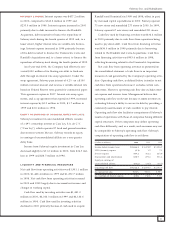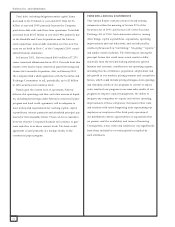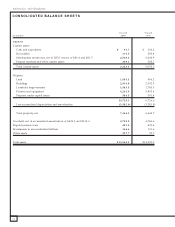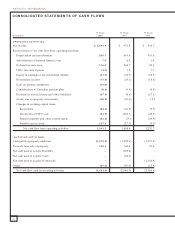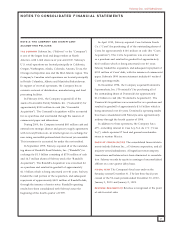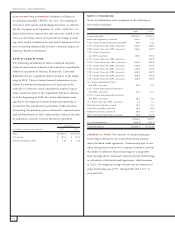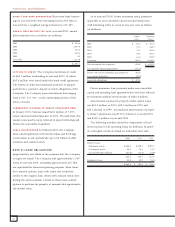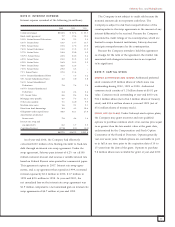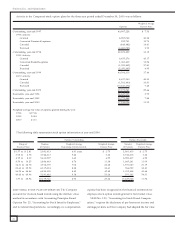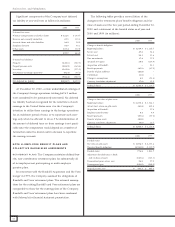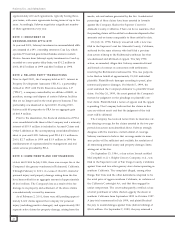Safeway 2000 Annual Report Download - page 33
Download and view the complete annual report
Please find page 33 of the 2000 Safeway annual report below. You can navigate through the pages in the report by either clicking on the pages listed below, or by using the keyword search tool below to find specific information within the annual report.
Safeway Inc. and Subsidiaries
31
FAIR VALUE OF FINANCIAL INSTRUMENTS Accounting
principles generally accepted in the United States of America
require the disclosure of the fair value of certain financial
instruments, whether or not recognized in the balance sheet,
for which it is practicable to estimate fair value. Safeway
estimated the fair values presented below using appropriate
valuation methodologies and market information available
as of year-end. Considerable judgment is required to develop
estimates of fair value, and the estimates presented are not
necessarily indicative of the amounts that the Company
could realize in a current market exchange. The use of
different market assumptions or estimation methodologies
could have a material effect on the estimated fair values.
Additionally, these fair values were estimated at year-end,
and current estimates of fair value may differ significantly
from the amounts presented.
The following methods and assumptions were used to
estimate the fair value of each class of financial
instruments:
Cash and equivalents, accounts receivable, accounts payable
and short-term debt The carrying amount of these items
approximates fair value.
Long-term debt Market values quoted on the New York Stock
Exchange are used to estimate the fair value of publicly trad-
ed debt. To estimate the fair value of debt issues that are not
quoted on an exchange, the Company uses those interest
rates that are currently available to it for issuance of debt
with similar terms and remaining maturities. At year-end
2000 and 1999, the estimated fair value of debt approximat-
ed carrying values.
Off -balance sheet instruments The fair value of interest rate
swap agreements are the amounts at which they could be
settled based on estimates obtained from dealers. At year-end
2000, the net unrealized loss on such agreements was
$1.9 million compared to net unrealized gains of $4.7 million
at year-end 1999. Because the Company intends to hold this
agreement as a hedge for the term of the agreement, the
market risk associated with changes in interest rates is not
expected to be significant.
STORE CLOSING AND IMPAIRMENT CHARGES Safeway con-
tinually reviews its stores’ operating performance and assesses
the Company’s plans for certain store and plant closures.
The write-down of long-lived assets at stores that were
assessed for impairment because of management’s intention
to close the store or because of changes in circumstances that
indicate the carrying value of an asset many not be recover-
able is recognized in accordance with Statement of Financial
Accounting Standards (SFAS) No. 121, “Accounting for the
Impairment of Long-Lived Assets and for Long-Lived Assets
to be Disposed Of.” Safeway recognized impairment charges
on the write-down of long-lived assets at stores to be closed
of $8.4 million in 2000, $15.2 million in 1999 and
$15.3 million in 1998. For stores to be closed that are under
long-term leases, the Company records a liability for the
future minimum lease payments and related ancillary costs,
from the date of closure to the end of the remaining lease
term, net of estimated cost recoveries that may be achieved
through subletting properties or through favorable lease ter-
minations, at the time management commits to closing the
store. The operating costs, including depreciation, of stores
or other facilities to be closed are expensed during the period
they remain in use. Safeway had an accrued liability of
$138.5 million at year-end 2000 and $180.6 million at year-
end 1999 for such store lease exit costs, which is included
in Accrued Claims and Other Liabilities in the Company’s
consolidated balance sheets.
GOODWILL Goodwill was $4.7 billion at year-end 2000 and
$4.8 billion at year-end 1999, and is being amortized on a
straight-line basis over its estimated useful life of 40 years. If
it became probable that the projected future undiscounted
cash flows of acquired assets were less than the carrying value
of the goodwill, Safeway would recognize an impairment
loss in accordance with the provisions of SFAS No. 121.
Goodwill amortization was $126.2 million in 2000,
$101.4 million in 1999 and $56.3 million in 1998.
STOCK-BASED COMPENSATION Safeway accounts for stock-
based awards to employees using the intrinsic value method
in accordance with Accounting Principles Board Opinion
No. 25, “Accounting for Stock Issued to Employees.” The
disclosure requirements of SFAS No. 123, “Accounting for
Stock-Based Compensation,” are set forth in Note F.


